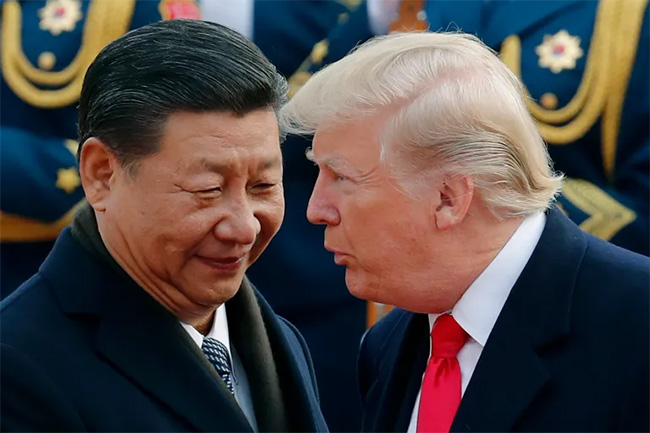China hits back with tariffs on US goods after Trump imposes new levies
February 4, 2025 11:19 am
China on Tuesday slapped tariffs on U.S. imports in a swift response to new U.S. duties on Chinese goods, renewing a trade war between the world’s top two economies as President Donald Trump sought to punish China for not halting the flow of illicit drugs.
Trump’s additional 10% tariff across all Chinese imports into the U.S. came into effect at 12:01 a.m. ET on Tuesday (0501 GMT).
Within minutes, China’s Finance Ministry said it would impose levies of 15% for U.S. coal and LNG and 10% for crude oil, farm equipment and some autos. The new tariffs on U.S. exports will start on Feb. 10, the ministry said.
China also said it was starting an anti-monopoly investigation in Alphabet Inc’s Google, while including both PVH Corp, the holding company for brands including Calvin Klein, and U.S. biotechnology company Illumina on its “unreliable entities list”.
Separately, China’s Commerce Ministry and its Customs Administration said it is imposing export controls on tungsten, tellurium, ruthenium, molybdenum and ruthenium-related items to “safeguard national security interests”. China controls much of the world’s supply of such rare earths that are critical for the clean energy transition.
Trump on Monday suspended his threat of 25% tariffs on Mexico and Canada at the last minute, agreeing to a 30-day pause in return for concessions on border and crime enforcement with the two neighbouring countries.
But there was no such reprieve for China, and a White House spokesperson said Trump would not be speaking with Chinese President Xi Jinping until later in the week.
During his first term in 2018, Trump initiated a brutal two-year trade war with China over its massive U.S. trade surplus, with tit-for-tat tariffs on hundreds of billions of dollars worth of goods upending global supply chains and damaging the world economy.
To end that trade war, China agreed in 2020 to spend an extra $200 billion a year on U.S. goods but the plan was derailed by the COVID pandemic and its annual trade deficit had widened to $361 billion, according to Chinese customs data released last month.
“The trade war is in the early stages so the likelihood of further tariffs is high,” Oxford Economics said in a note as it downgraded its China economic growth forecast.
Trump warned he might increase tariffs on China further unless Beijing stemmed the flow of fentanyl, a deadly opioid, into the United States.
“China hopefully is going to stop sending us fentanyl, and if they’re not, the tariffs are going to go substantially higher,” he said on Monday.
China has called fentanyl America’s problem and said it would challenge the tariffs at the World Trade Organization and take other countermeasures, but also left the door open for talks.
Stocks in Hong Kong pared gains after China’s retaliation.
“Unlike Canada and Mexico, it is clearly harder for the U.S. and China to agree on what Trump demands economically and politically. The previous market optimism on a quick deal still looks uncertain,” said Gary Ng, senior economist at Natixis in Hong Kong.
“Even if the two countries can agree on some issues, it is possible to see tariffs being used as a recurrent tool, which can be a key source of market volatility this year.”
Neighbourly Deals
There was relief in Ottawa and Mexico City, as well as global financial markets, after the deals to avert the hefty tariffs on Canada and Mexico.
Both Canadian Prime Minister Justin Trudeau and Mexican President Claudia Sheinbaum said they had agreed to bolster border enforcement efforts in response to Trump’s demand to crack down on immigration and drug smuggling. That would pause 25% tariffs due to take effect on Tuesday for 30 days.
Canada agreed to deploy new technology and personnel along its border with the United States and launch cooperative efforts to fight organized crime, fentanyl smuggling and money laundering.
Mexico agreed to reinforce its northern border with 10,000 National Guard members to stem the flow of illegal migration and drugs.
The United States also made a commitment to prevent trafficking of high-powered weapons to Mexico, Sheinbaum said.
“As President, it is my responsibility to ensure the safety of ALL Americans, and I am doing just that. I am very pleased with this initial outcome,” Trump said on social media.
Canadian industry groups, fearful of disrupted supply chains, welcomed the pause.
“That’s very encouraging news,” said Chris Davison, who heads a trade group of Canadian canola producers. “We have a highly integrated industry that benefits both countries.”
Trump suggested on Sunday the 27-nation European Union would be his next target, but did not say when.
EU leaders at an informal summit in Brussels on Monday said Europe would be prepared to fight back if the U.S. imposes tariffs, but also called for reason and negotiation. The U.S. is the EU’s largest trade and investment partner.
Trump hinted that Britain, which left the EU in 2020, might be spared tariffs.
Trump acknowledged over the weekend that his tariffs could cause some short-term pain for U.S. consumers, but says they are needed to curb immigration and narcotics trafficking and spur domestic industries.
The tariffs as originally planned would cover almost half of all U.S. imports and would require the United States to more than double its own manufacturing output to cover the gap - an unfeasible task in the near term, ING analysts wrote.
Other analysts said the tariffs could throw Canada and Mexico into recession and trigger “stagflation” - high inflation, stagnant growth and elevated unemployment - at home.
Source: Reuters
--Agencies














